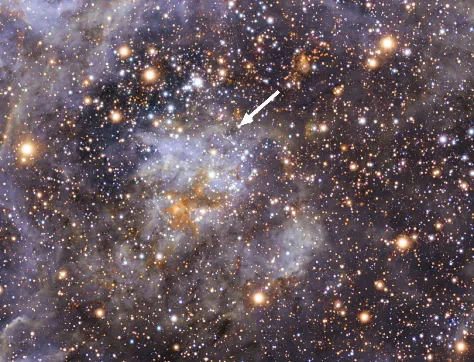
Located in the Tarantula Nebula in the Large Magellanic Cloud, VFTS 102 is 25 times as big as the Sun, and spins on its axis over 300 times faster
Credit: ESO/M.-R. Cioni/VISTA Magellanic Cloud survey
The European Southern Observatory's Very Large Telescope in Paranal, Chile has identified the fastest-rotating star yet discovered. VFTS 102 is around 25 times the size of the Sun, shines 100,000 times brighter and rotates over 300 times faster, spinning on its axis at two million kilometres per hour. That's close to the point at which the star would start to be torn apart by centrifugal forces; an aircraft travelling at this speed would be able to circle Earth's equator in just one minute.
VFTS 102 lies about 160,000 lightyears from Earth, but astronomers think its dizzying rotation and slow movement relative to other nearby stars (VFTS 102 is moving at about 228 km/s, 40 km/s slower than its neighbours) may indicate that it has previously been expelled from a double star system by its partner exploding. The presence nearby of a pulsar and a supernova remnant lend further weight to this theory.
The star was detected using the Fibre Large Array Multi Element Spectograph (FLAMES) on the Very Large Telescope, as part of the VLT-FLAMES Tarantula Survey.